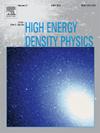High-precision room temperature Fe opacity measurements at 1000-2000eV photon energies
Abstract
Prior measurements of room temperature (cold) Fe opacity have errors as high as ±10 % and a spread in values that exceeds the uncertainties. These data, along with current cold opacity databases, were used for comparison with experimental solar Fe opacity. The solar Fe opacity is expected to be lower than cold Fe opacity in the ∼1500–2000 eV photon energy range. However, results from this comparison contradicted this assumption and prompted an investigation of the precision and accuracy of cold Fe opacity measurements. Cold Fe opacity is determined here with high precision using transmission measurements of Fe foils at three characteristic line energies in the soft X-ray range (1000–2000 eV). The present opacities are determined with ≲1 % overall uncertainties. This is achieved through precise measurements of transmission and areal density which are related to opacity by the Beer-Lambert Law. Transmission is measured with overall individual uncertainties of ≲1 % and is obtained through simultaneous measurements of attenuated and unattenuated spectra using an X-ray source and a Bragg crystal spectrometer. The required areal density is indepen-dently measured using two different techniques: Rutherford Backscattering Spectroscopy and a recently-developed technique using calibrated cold absorption in the 3–17 keV range. The final areal density used in the opacity determination is an average between both methods. The measured opacity at 1188 eV is in agreement with current opacity databases but is higher by around 5–10 % at the highest photon energy (1924 eV) and lower by around 2–4 % at the lowest photon energy (1012 eV). A caveat is that opacity accuracy is linearly dependent on the areal density. We performed the first direct comparison between the two areal density methods which revealed a 7–11 % discrepancy. If one of the methods is proven correct in future studies, it may impact the opacity accuracy reported here since we use the average of the two methods. This result affects the solar Fe opacity measurements as they also rely on the accuracy of these areal density measurement techniques.

 求助内容:
求助内容: 应助结果提醒方式:
应助结果提醒方式:


